Florence: The Historic Center, from the Duomo to the Ponte Vecchio
To say that Florence’s historic center, stretching from the Piazza del Duomo in the north to the Giardino Boboli across the Arno to the south, is beautiful could be misconstructed as an understatement.
Indeed, this relatively small area is home to some of the most important artistic treasures in the world. The smorgasbord of churches, medieval towers, Renaissance palazzi (palaces), and world-class museums and galleries is not a static testimony to the artistic and architectural genius of the past millennium, but a shrine to some of the most outstanding aesthetic achievements of Western history.
A Good Walk
Start at the Duomo and Battistero, climbing the Campanile if you wish, yhen visit the Museo dell’Opera del Duomo, behind the Duomo.
You can go directly south from in front of the Duomo to the Piazza della Signoria by way of Via dei Calzaiuoli (from here you can take a detour west on Via Speziali to Piazza della Repubblica, passing Orsanmichele, or go isntead directly south from the Museo dell’Opera del Duomo along Via del Proconsolo to the Bargello (opposite the ancient Badia Fiorentina, built in 1285).
From the Bargello head west on Via della Condotta to Via Calzauioli, then south to discover the architectural splendors of the Piazza della Signoria, including the Loggia dei Lanzi and the Palazzo Vecchio.
The Palazzo degli Uffizi, Italy’s most important art gallery, is off the south side of the piazza. Leave the piazza from the southwest corner along Via Vacchereccia.
To the left, at the corner with Via Por Santa Maria (lined with stores), is the Mercato Nuovo. Follow Via Por Santa Maria to the river; wlak est along the north side of the Arno to Piazza dei Giudici to see the Museo di Storia della Scienza. Backtrack west along the Arno to the Ponte Vecchio.
Timing
Before much of the centro storico (historic center) of Florence was closed to the traffic, you had to keep dodging passing cars and moped as you walked the narrow streets. Now you have to elbow your way through moving masses of fellow tourists, especially in the neighbourhood delimited by the Duomo, Piazza Signoria, Uffizi, and Ponte Vecchio.
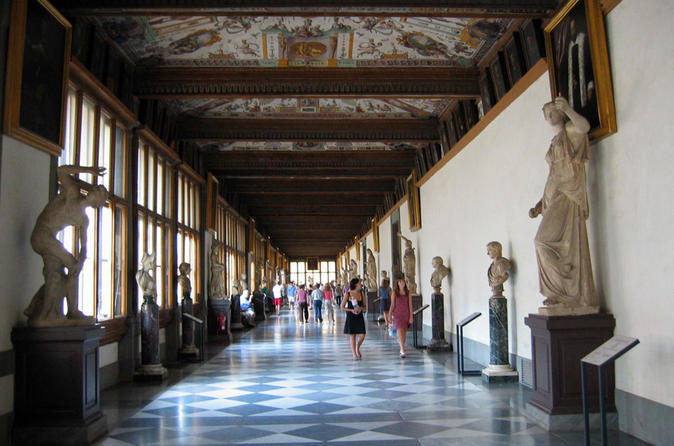
It takes about 40 minutes to walk the route, with 45 minutes to one hour each for the Museo dell’Opera del Duomo and for Palazzo della Signoria; one to 1,5 hours for the Bargello, and a minimum of two hours for the Uffizi (reserve tickets in advance to avoid long lines).
A special museum ticket valid for six months at seven city museums, including the Palazzo Vecchio, the Museo di Firenze Com’era (Museum of Florence History) and the Museo di Santa Maria Novella is a good buy if you’re planning to visit some of these museums. Inquire at any city museum.

Sight to See
Badia Fiorentina

The ancient church was built in 1285; its graceful bell tower—best seen from the interiour courtyard–is one of the most beautiful in Florence.
The interior of the church proper was halfheartedly remodelled in the Baroque style during the 17th century; its best-known work of art is Filippo Lippi’s (1457-1504) delicate Vision of St. Bernard, on the left as you enter. The painting–one of Lippi’s finest—is in superb condition; take a look at the Virgin’s hands, perhaps the most beautiful in the city.
Address: Via del Proconsolo.
Bargello
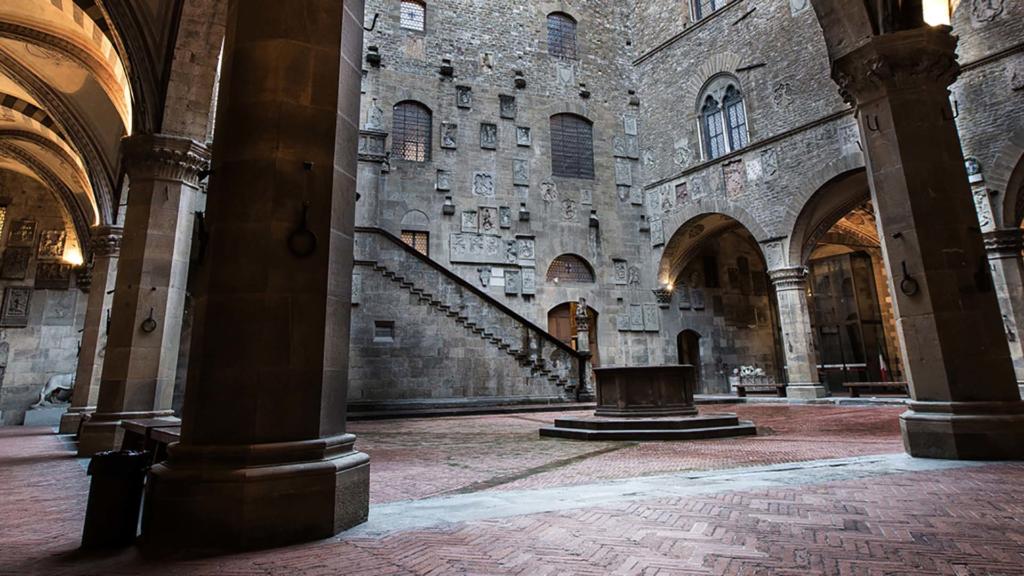
During the Renaissance this building was used as a prison, and the exterior served as a “most wanted” billboard. Effigies of notorious criminals and Medici enemies were painted on its walls.
Today is houses of Museo Nazionale, home to what is probably the finest collection of Renaissance sculpture in Italy. Michelangelo (1475-1564) , Donatello (1386-1466), and Benvenuto Cellini (1500-1571) are the preeminent masters here, and the concentration of masterworks is remarkable, though they stand among an eclectic array of arms, ceramics, and enamels.
For Renaissance art lovers, the Bargello is to sculpture what the Uffizi is to painting.
One particular display, easily overlooked, should not be missed. In 1401 Filippo Brunelleschi (1377-1446) and Lorenzo Ghiberti (1378-1455) competed to earn the most perstigious commission of the day: the decoration of the north doors of the baptistery in Piazza del Duomo. For the competition, each designed a bronze bas-relief panel on the theme of the Scrifice of Isaac; both panels are on display, side by side, in the room devoted to the sculpture of Donatello on the upper floor.
The judges chose Ghiberti for the commission; you can decide for yourself whether or not they were right.
Address : Via del Proconsolo 4
Battistero (Baptistery)

The octagonal baptistery is one of the supreme monuments of the Italian Romanesque and one of Florence’s oldest. Local legend has it that it was once a Roman temple of Mars; modern excavations, however, suggest its foundation was laid in the 4th-5th and 7th-8th centuries AD, well after the collapse of the Roman Empire.
The round-arched Romanesque decoration on the exterior probably dates from the 11th or 12th century. The interior ceiling mosaics (finished in 1297) are justly famous, but—glitteringly beautiful as they are–they could never outshine the building’s most renowned feature: its bronze Renaissance doors decorated with panels crafted by Lorenzo Ghiberti.
The doors, on which Ghiberti spent most of his adult life, from 1403 to 1452, are on the north and east sides of the baptistery–at least copies are—and the Gothic south door panels were designed by Andrea Pisano (1270-1348) in 1330.
The original of the Ghiberti doors were removed to protect them from the effects of pollution and acid rain and have been beautifully restored; some of the panels are now on display in the Museo dell’Opera del Duomo.

Ghiberti’s north door depict scenes from the life of Christ; his later east doors, facing the Duomo facade, render scenes from the Old Testament. They merit close examination, for they are very different in style and illustrate with great clarity the artistic changes that marked the beginning of Renaissance.
Look at the far right panel of the middle row on the earlier north doors (Jesus Calming the Waters). Ghiberti here captured the chaos of a storm at sea with great skill and economy, but the artistic convention he used are basically pre-Renaissance: Jesus is the most important figure, so he is the largest; the disciples are in the next in size, being next in importance, the ship on which they founder looks like a mere toy.
The panels on the east doors are larger, more expansive, and more convincing. Look at the middle panel on the left-hand door. It tells the story of Jacob and Esau, and the various episodes of the story (the selling of the birthright, Isaac ordering Esau to go hunting, the blessing of Jacob, and so forth) have been merged into a single beautifully realized street scene.
A perspective grid is employed to suggest depth, the background architecture looks far more credible than on the north door panels, the figures in the foreground are grouped realistically, and the naturalism and grace of the poses (look at Esau’s left leg) have nothing to do with the sacred message being conveyed.
Although the religious content remains, man and his place in the natural world are given new prominence and are portrayed with a realism not seen in art since the fall of the Roman Empire, more than a thousand years before.
As a footnote to Ghiberti’s panels, one small detail of the east doors is worth a special look. Just to the lower left of the Jacob and Esau Panel, Ghiberti placed a tiny self-portrait bust. From either side, the portrait is extremely appealing—Ghiberti looks like everyone’s favourite uncle—but the bust is carefully placed so that there is a single spot from which you can make direct eye contact with the tiny head.
When that contact is made, the impression of intelligent life—of modern intelligent life–is astonishing. It is no wonder that when these doors were completed, they received on of the most famous compliments in the history of art, from a competitor known to be notoriously stingy with praise: Michelangelo himself declared them so beautiful that they could serve as the Gates of Paradise.
Address: Piazza del Duomo
TOURS FROM FLORENCE:
Chianti Lovers Tour- 3 Wineries, Chianti and SuperTuscan with Light Lunch from Florence
Bella Toscana – Private Chianti, SuperTuscan and San Gimignano with light lunch Tour From Florence
One Day Tour To Discover All Tuscany: Siena, San Gimignano & Chianti Wine from Florence
Exclusive Cinque Terre Tour by ferry-Boat (and Minivan) from Florence
San Gimignano and Volterra Private Day Tour from Florence
Montalcino and Brunello Wine One Day Private Tour from Florence
Exclusive Walking Pisa Guided Tour from Florence
Campanile
Giotto’s (1266-1337) bell tower is a shaft of multicolor marble decorated with reliefs now in the Museo dell’Opera del Duomo.
A climb of 414 steps rewards you with a close-up of Brunelleschi’s dome and a sweeping view of the city.
Address: Piazza del Duomo
Duomo (Cattedrale di Santa Maria del Fiore)
In 1296 Arnolfo di Cambio (1245-1302) was commissioned to build “the loftiest, most sumptuous edifice human invention could devise” in the newest Romanesque style on the site of the old church of Santa Reparata.
The immense Duomo was not completed until 1436, the year when it was consecrated. The imposing facade dates only from the 19th century; it was added in the neo-Gothic style to complement Giotto‘s genuine Gothic 14th-century campanile. The real glory of the Duomo, however, is Filippo Brunelleschi‘s dome, presiding over the cathedral with a dignity and grace that few domes, even to this day, can match.
Brunelleschi’s cupola was epoch-making as an engineering feat. The space to be enclosed by the dome was so large and so high above the ground that traditional methods of dome construction—wooden centering and scaffolding—were of no use whatever. So Brunelleschi developed entirely new building methods, which he implemented with equipment of his own device (including the modern crane).
Beginning work in 1420, he built not one dome but two, one inside the other, and connected them with common ribbing that stretched across the intervening empty space, thereby considerably lessening the crushing weight of the structure. He also employed a new method of bricklaying, based on an ancient Roman herringbone pattern, interlocking each new course of bricks with the course below in a way that made the growing structure self-supporting.
The result was one of the great engineering breakthroughs of all time: Most of Europe’s great domes, including St.Peter’s in Rome, were built employing Brunelleschi’s methods, and today the Duomo has come to symbolize Florence in the same way that the Eiffel Tower symbolizes Paris. The Florentine are justly proud, and to this day the Florentine phrase for “homesick” is nostalgia del cupolone (homesick for the dome).
The interior is a fine example of Florentine Gothic. Much of the cathedral’s best-known has been moved to the nearby Museo dell’Opera del Duomo. Notable among the works that remain, however, are two equestrian frescoes honoring famous soldiers: Andrea del Castagno’s Niccolò de Tolentino, painted in 1456, and Paolo Uccello’s (1397-1475) Sir John Hawkwood, painted 20 years earlier, both are on the left-hand wall of the nave.
Niccolò da Tolentino is particularly impressive: He rides his fine horse with a military pride and wears his even finer hat—surely the best in town—with panache. Restores worked from 1983 to 1995 to repair the structure of Brunelleschi’s dome and clean the vast and crowded fresco of the Last Judgment—painted by Vasari and Zuccaro–on its interior. Originally Brunelleschi wanted mosaics to cover the interior of the great ribbed cupola, but by the time the Florentines got around to commissioning the decoration, 150 years later, tastes had changed.
You can explore the upper and lower reaches of the cathedral. Ancient remains have been excavated beneath the nave; the stairway down is near the first pier on the right. The climb to the top of the dome (463 steps) is not for the faint of heart, but the view is superb; the entrance is on the left wall just before the crossing.
Address: Piazza del Duomo
Mercato Nuovo (New Market)
This open air-loggia was new in 1551. Today it host mostly souvenir stands; its main attraction is Piero Tacca’s bronze Porcellino (Little Pig) fountain on the south side, dating from around 1612 and copied from an earlier Roman work now in the Uffizi.
Rubbing its drooling snout is a Florentine tradition, said to bring good luck.
Address: Corner of Via Por Santa Maria and Via Porta Rossa.
TOURS FROM FLORENCE:
Chianti Lovers Tour- 3 Wineries, Chianti and SuperTuscan with Light Lunch from Florence
Bella Toscana – Private Chianti, SuperTuscan and San Gimignano with light lunch Tour From Florence
One Day Tour To Discover All Tuscany: Siena, San Gimignano & Chianti Wine from Florence
Exclusive Cinque Terre Tour by ferry-Boat (and Minivan) from Florence
San Gimignano and Volterra Private Day Tour from Florence
Montalcino and Brunello Wine One Day Private Tour from Florence
Exclusive Walking Pisa Guided Tour from Florence
Museo dell’Opera del Duomo (Cathedral Museum)
The major attraction here–other than Ghiberti’s original Baptistery door panels and the cantorie (choir loft) reliefs by Donatello‘s Mary Magdalen and Michelangelo‘s Pietà (not to be confused with his more famous Pietà in St.Peter’s).
The Renaissance in sculpture is in part defined by its revolutionary realism, but Donatello’s Magdalen goes beyond realism. It is suffering incarnate. Michelangelo’s heart-wrenching Pietà was unfinished at his death; the female figure supporting the body of Christ on the left was added by one Tiberio Calcagni, and never has the difference between competence and genius been manifested so clearly.
Address: Piazza del Duomo
Museo di Storia della Scienza (Museum of Science History)
Though it tends to be obscured by the glamour of the neighboring Uffizi, this science museum has a wealth of interest: Galileo’s own instruments, a collection of antique armillary spheres, some of them real works of art, and a host of other reminders that the Renaissance made not only artistic but also scientific history.
Address: Piazza dei Giudici 1
Orsanmichele
This church containing a beautifully detailed 14th-century Gothic tabernacle by Andrea Orcagna (1308-1368), was originally a granary.
The building was transformed in 1336 into a church with 14 exterior niches. Each of the major Florentine trade guilds was assigned its own niche and paid for the sculpture the niche was to contain. The niches soon held works by Florence’s most talented sculptors. Unfortunately, the best have been removed and replaced with copies. The originals will eventually be placed in a museum, perhaps even in Orsanmichele.
Even so, all the statues are worth examining. One of those removed—Andrea del Verrocchio‘s (1435-1488) Doubting Thomas (1470)–was particularly deserving of attention. Were the niche not empty, you would see Christ, like the building’s other figures, entirely framed within the niche, and St. Thomas standing on its bottom ledge, with his right foot outside the niche frame.
Address: Via dei Calzaiuoli
Palazzo degli Uffizi (Uffizi Palace)
The Galleria degli Uffizi (Uffizi Gallery) occupies the top floor of this U-shape building fronting on the Arno, designed by Giorgio Vasari (1511-1574) in 1559 to hold the administrative offices of Medici Grand Duke Cosimo I (1519-1574)—uffizi means offices in Italian. And here later Medicis installed their art collections, creating what was Europe’sfirst modern museum, open to the public (at first only request, of course) since 1591.
Today, the palazzo houses the finest collection of paintings in Italy. If you’re a hard-core museum aficionado, you might want to pick up a complete guide to the collections, sold in bookshops and on newsstands.
The collection highlights include Paolo Uccello‘s Battle of San Romano (its brutal chaos of lances is one of the finest visual metaphors for warfare ever committed to paint); Fra Filippo Lippi‘s (1406-1469) Madonna and Child with Two Angels (the foreground angel’s bold, imprudent eye contact would have been unthinkable prior to the Renaissance); Sandro Botticelli‘s (1445-1510) ethereal interpretation of the Birth of Venus and Primavera (its nonrealistic fairy-tale charm exhibits the painter’s idiosyncratic genius at its zenith); Leonardo da Vinci‘s (1452-1519) Adoration of the Magi (unfinished and perhaps the best opportunity in Europe to investigate the methods of a great artist at work); Raphael‘s (1483-1520) Madonna of the Goldfinch (darkened by time, but the tenderness with which the figures in the painting touch each other is undimmed); Michelangelo‘s Holy Family (one of the very few easel works in oil ever painted, clearly reflecting his stated belief that draftmanship is a necessary ingredient of great painting); Rembrandt‘s (1606-1669) Self-Portrait as an Old Man; Titian‘s (1488-1576) Venus of Urbino; and Caravaggio‘s (1573-1610) Bacchus (two very great paintings whose attitudes toward myth and sexuality are–to put in mildly–diametrically opposed).
If panic sets in at the prospect of absorbing all this art at one go, bear in mind that the Uffizi is, expect on Sunday, open late and isn’t usually crowded in the late afternoon.
The coffee bar inside the Uffizi has a terrace with a fine close-up view of Palazzo Vecchio.
Address: Piazzale degli Uffizi 6
TOURS FROM FLORENCE:
Chianti Lovers Tour- 3 Wineries, Chianti and SuperTuscan with Light Lunch from Florence
Bella Toscana – Private Chianti, SuperTuscan and San Gimignano with light lunch Tour From Florence
One Day Tour To Discover All Tuscany: Siena, San Gimignano & Chianti Wine from Florence
Exclusive Cinque Terre Tour by ferry-Boat (and Minivan) from Florence
San Gimignano and Volterra Private Day Tour from Florence
Montalcino and Brunello Wine One Day Private Tour from Florence
Exclusive Walking Pisa Guided Tour from Florence
Palazzo Vecchio (Old Palace)
Looming over Piazza Della Signoria is Florence’s forbidding, fortress-like city hall. The palazzo was begun in 1299 and designed (probably) by Arnolfo di Cambio, and its massive bulk and towering campanile dominate the piazza. It was built as a meeting place for the heads of the seven major guilds that governed the city at the time; over the centuries it has served lesser purposes, but today it is once again the City Hall of Florence.
The interior courtyard is a good deal less severe, having been remodelled by Michelozzo (1396-1472) in 1453; the copy of Verrocchio‘s bronze puttino (little putto), topping the ventral fountain, softens the effect considerably.
The main attraction is on the second floor: two adjoining rooms that supply one of the most startling contrasts in Florence. The first is in the vast Sala dei Cinquecento (Room of the Five Hundred), named for the 500-member Great Council, the people’s assembly established by Savonarola, that met here.
The sala was decorated by Giorgio Vasari, around 1570, with huge–almost grotesquely huge–frescoes celebrating Florentine history; depictions of battles with nearby cities predominate. Continuing the martial theme, the Sala also contains Michelangelo‘s Victory group, intended for the never-completed tomb of Pope Julius II, plus other sculptures of decidedly lesser quality.
The second room is the little Studiolo, to the right of the Sala’s entrance. The study of Cosimo de’ Medici son, the melancholy Francesco I (1541-1587), it was designed by Vasari and decorated by Vasari and Agnolo Bronzino. It is intimate, civilized, and fully with complex, questioning, allegorical art. It makes the vainglorious proclamations next door ring more than a little hollow.
Address: Piazza della Signoria
Piazza della Repubblica
This square marks the site of the ancient forum that was the core of the original Roman settlement. The street plan in the area around the piazza still reflects the carefully plotted orthogonal grid of the Roman military encampment. The Mercato Vecchio (Old Market), located here since the Middle Ages, was demolished at the end of the last century, and the current piazza was constructed between 1885 and 1895 as a neoclassical showpiece.
Nominally the centre of town, it has yet to earn the love of most Florentines.
Piazza della Signoria
This is by far the most striking square in Florence. It was here, in 1497, that the famous “bonfire of the vanities” took place, when the fanatical monk Savonarola induced his followers to hurl their worldly goods into the flames; it was also here, a year later, that he was hanged as a heretic and, ironically, burned. A bronze plaque in the piazza pavement marks the exact spot of his execution.
The statues in the square and in the 14th-century Loggia dei Lanzi on the south side vary in quality. Cellini‘s famous bronze Perseus Holding the Head of Medusa is his masterpiece; even the pedestal is superbly executed. Other works in the loggia include The Rape of the Sabine Women and Hercules and the Centaur, both late 16th-century works by Giambologna (1529-1608), and in the back, a row of sober matrons that date from Roman times.
In the square, Bartolomeo Ammannati’s (1511-1592) Neptune Fountain, dating from 1550 to 1575, takes something of a booby prize. Even Ammannati himself considered it a failure, and the Florentines call it “Il Biancone”, which may be translated as ” the big white man” or “the big white lump”, depending on your point of view.
Giambologna‘s equestrian statue, to the left of the fountain, pays tribute to the Medici Gran Duke Cosimo I. Occupying the steps of the Palazzo Vecchio are a copy of Donatello’s proud heraldic lion of Florence, known as the Marzocco (the original is now in the Bargello); a copy of Donatello‘s Judith and Holofernes (the original is inside the Palazzo Vecchio); a copy of Michelangelo‘s David (the original is now in the Galleria dell’Accademia); and Baccio Bandinelli‘s Hercules.
TOURS FROM FLORENCE:
Chianti Lovers Tour- 3 Wineries, Chianti and SuperTuscan with Light Lunch from Florence
Bella Toscana – Private Chianti, SuperTuscan and San Gimignano with light lunch Tour From Florence
One Day Tour To Discover All Tuscany: Siena, San Gimignano & Chianti Wine from Florence
Exclusive Cinque Terre Tour by ferry-Boat (and Minivan) from Florence
San Gimignano and Volterra Private Day Tour from Florence
Montalcino and Brunello Wine One Day Private Tour from Florence
Exclusive Walking Pisa Guided Tour from Florence
Ponte Vecchio (Old Bridge)
This elegant bridge is to Florence what Tower Bridge is to London. It was built in 1345 to replace an earlier bridge that was swept away by flood, and its shops housed first butchers, then grocers, blacksmiths, and other merchants. But in 1593 the Medici Grand Duke Ferdinando I, whose private corridor linking the Medici Palace (Palazzo Pitti) with the Medici offices (the Uffizi) crossed the bridge atop the shops, decided that all this plebeian commerce under his feet was unseemly.
So he threw out all the butchers and blacksmiths and installed 41 goldsmiths and eight jewellers. The bridge has been devoted solely to these two trades ever since.
Take a moment to study the Ponte Santa Trinita, the next bridge downriver. It was designed by Bartolomeo Ammannati in 1567 (possibly from sketches by Michelangelo), blown up by the retreating Germans during World War II, and painstakingly reconstructed after the war ended.
By virtue of its graceful arc and delicate curves, Florentines like to claim it is the most beautiful bridge in the world. Given its simplicity, this may sound like idle Tuscan boasting.
Map

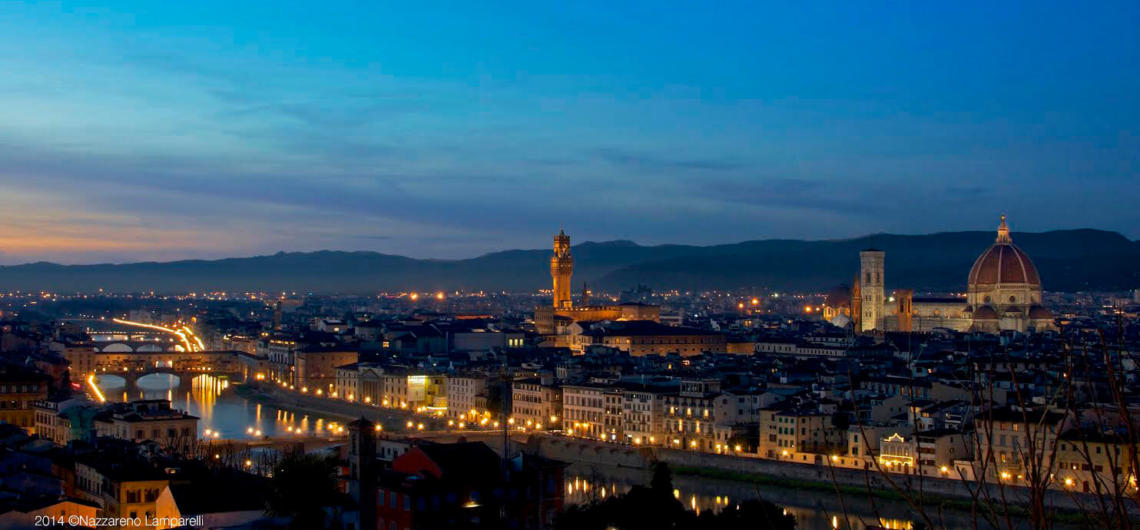

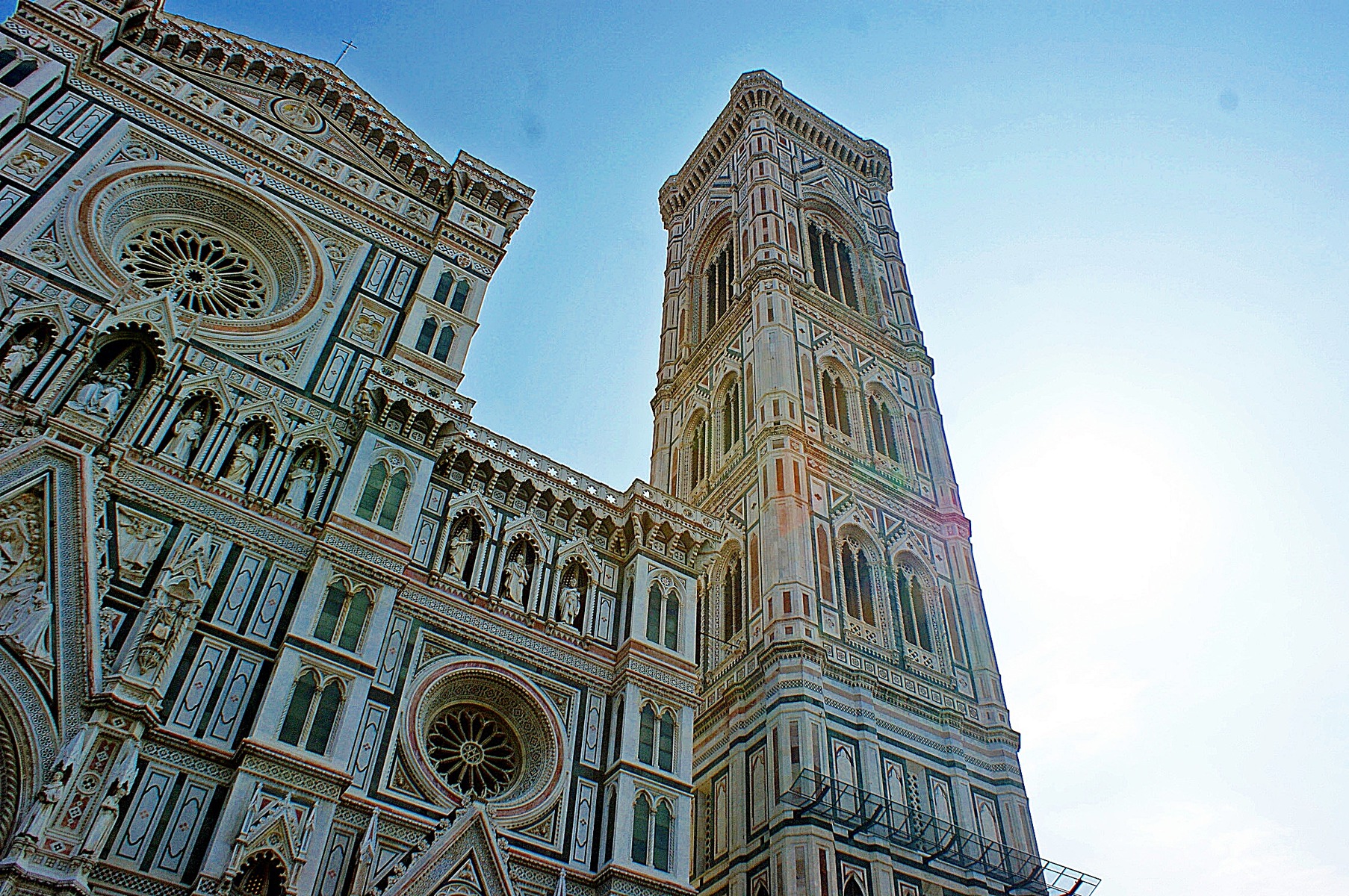
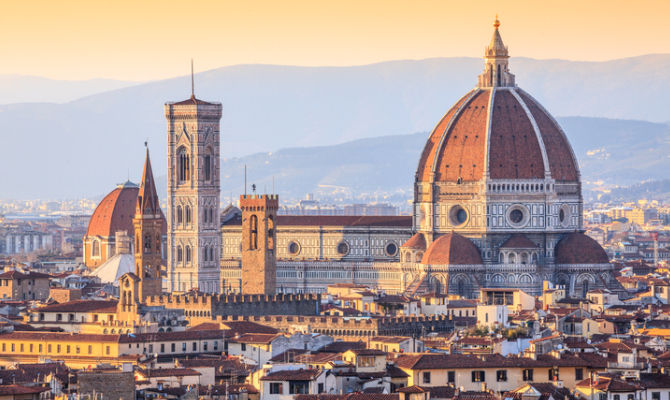
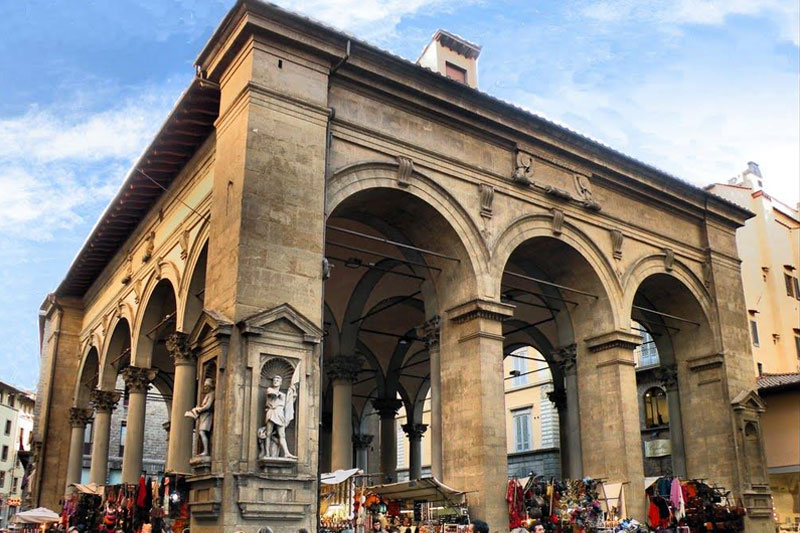
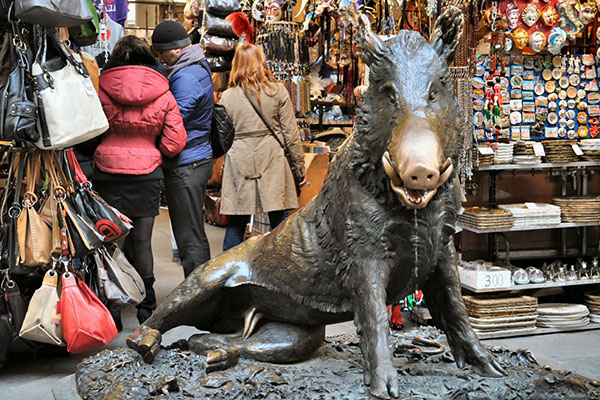


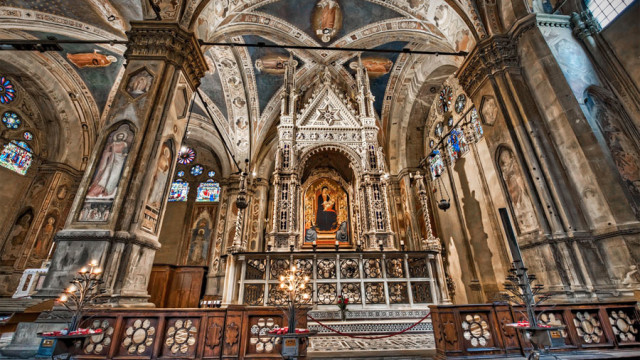
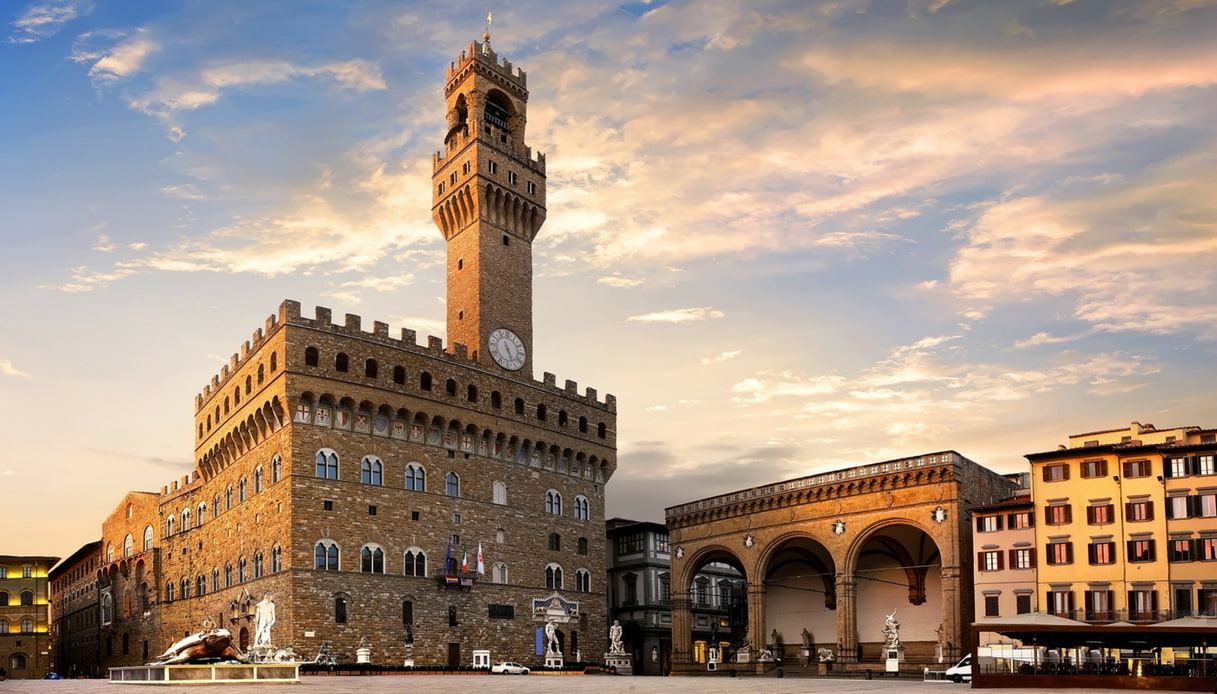
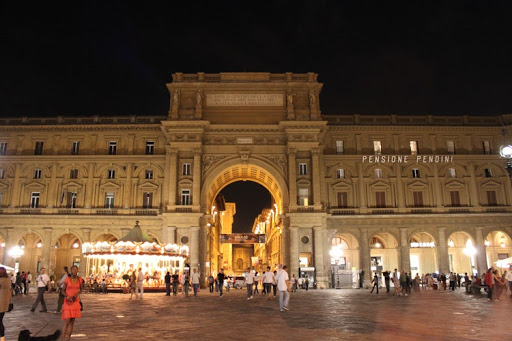
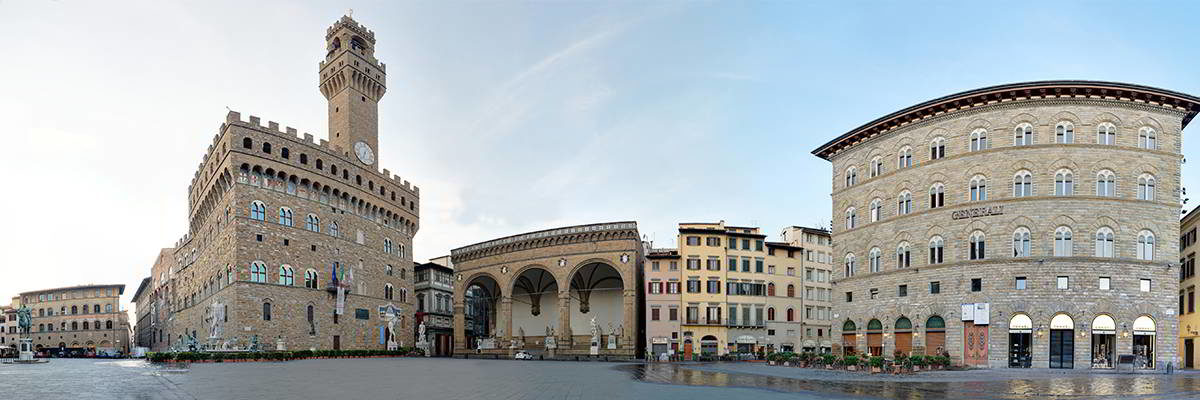

Comments